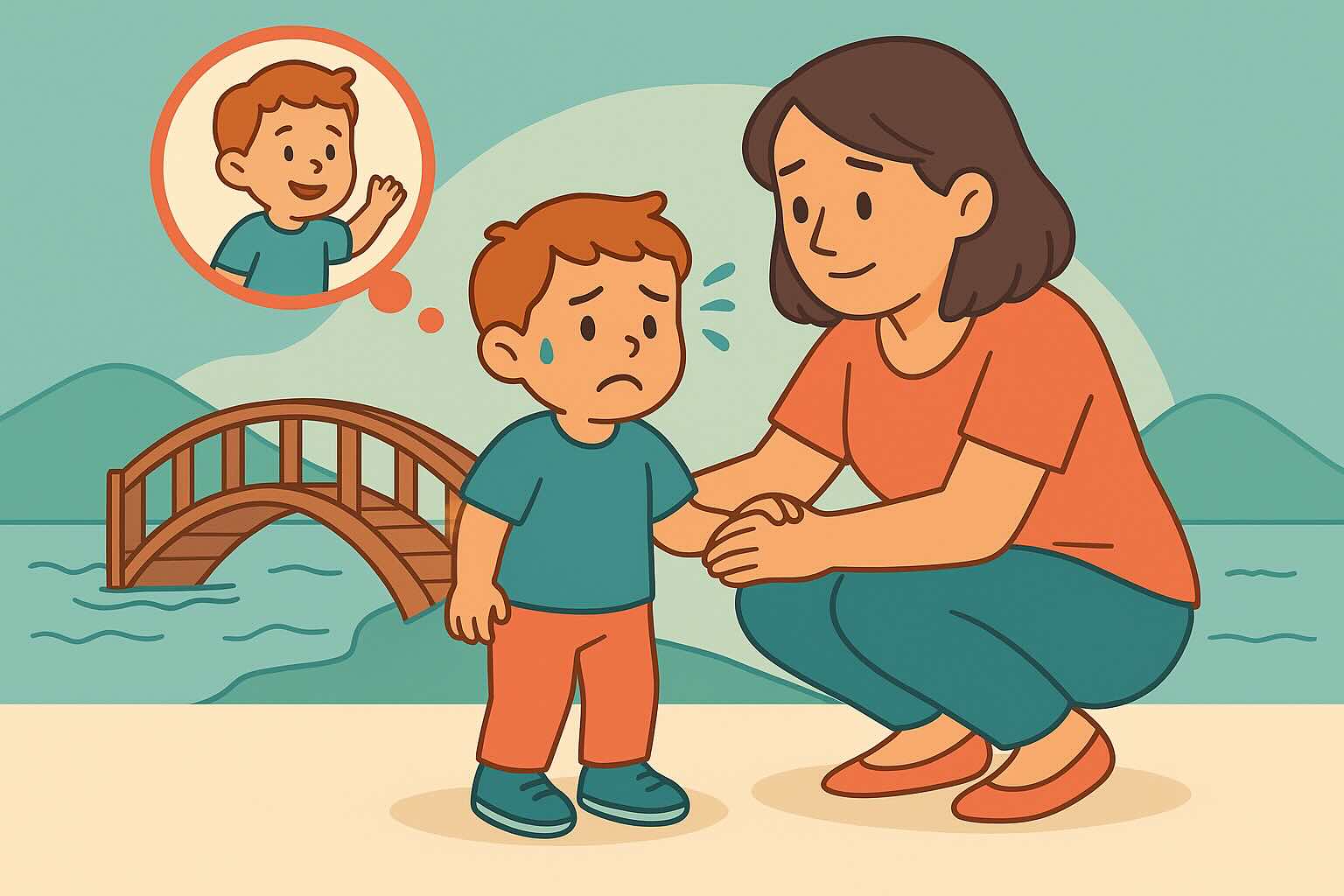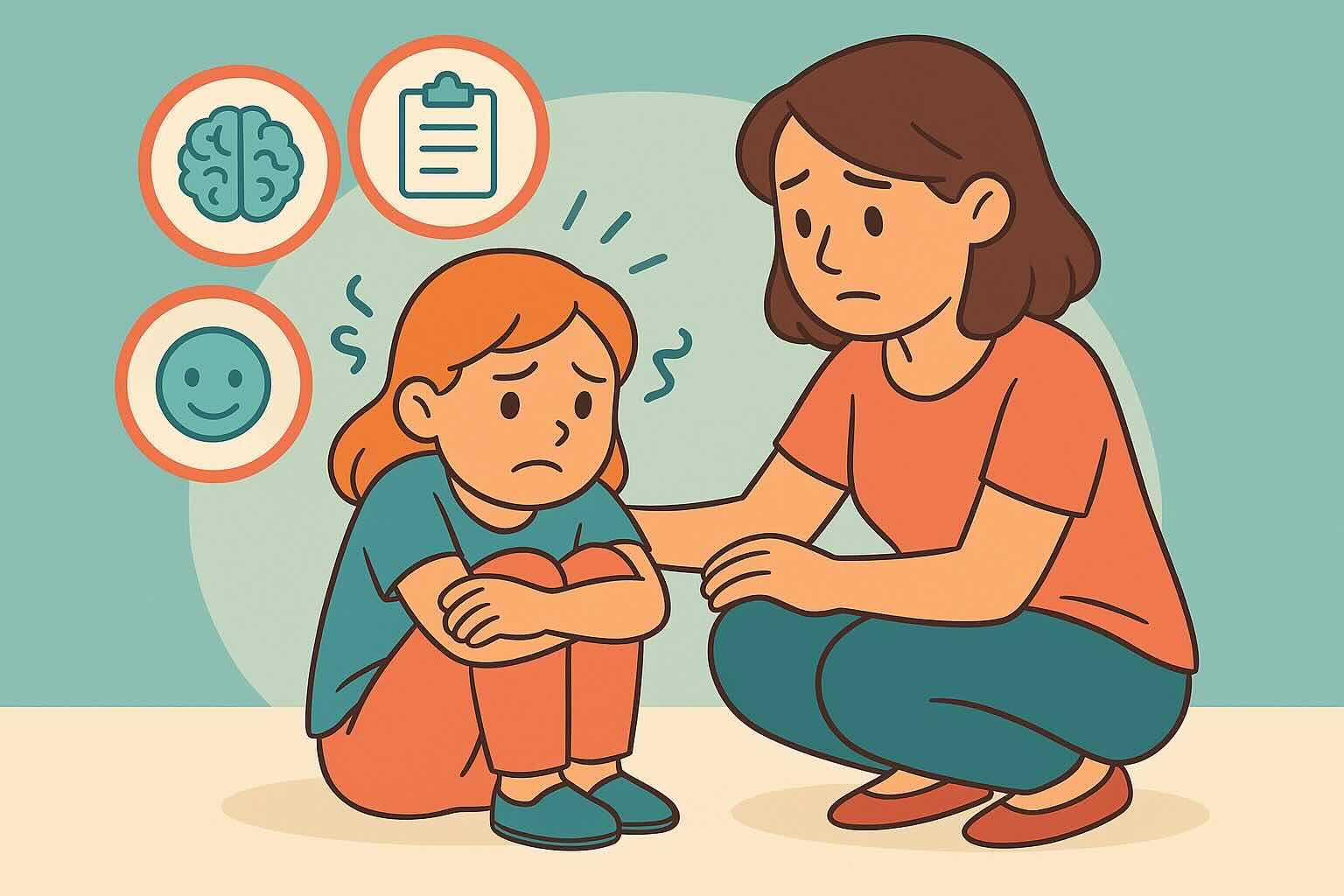When Your Child Fears New Experiences: 6 Steps


Your 4-year-old refuses to try the new playground equipment. Your 6-year-old won't taste unfamiliar foods. Your 5-year-old clings to you at every new activity, birthday party, or social gathering. Fear of new experiences affects 40-60% of young children and often reflects temperamental sensitivity rather than a character flaw or parenting mistake.
This comprehensive guide provides evidence-based strategies from temperament research, tested by real families. No more confusion about whether to push or accommodate—just practical tools with realistic expectations about building confidence.
For related challenges, also check out our childhood anxiety guide and room independence strategies. Also explore our guides on nighttime fears and trauma processing.
What You'll Learn in This Guide
- The Real Science - Why some children are naturally more cautious with new experiences
- Honest Statistics - Realistic data about cautious temperament patterns and development
- The Bridge-Building Method - Exactly how to connect familiar to unfamiliar gradually
- Preparation Strategies - How advance planning reduces new experience anxiety
- Age-Specific Approaches - Different techniques for 3-4 vs 5-7 year olds
- Building on Strengths - How cautious traits become valuable life skills
- When Fear Becomes Limiting - Recognizing when professional support is needed
Estimated reading time: 10 minutes
Why Some Children Fear New Experiences: The Brain Science Every Parent Should Know
Your Child's Brain: The Neuroscience of Caution
Approximately 15-20% of children are born with what researchers call "behavioral inhibition"—a temperamental tendency toward caution when encountering new situations. This isn't learned behavior or overprotective parenting; it's a fundamental difference in how their nervous system processes novel information.
This means your child literally experiences new situations as more overwhelming than other children. Their amygdala (fear detection system) has a lower threshold for activation, and they notice more details and potential problems in unfamiliar environments.
Important note: While this temperament can feel challenging for parents, research reveals significant advantages to this careful approach. Cautious children often develop exceptional problem-solving skills, deep relationships, and strong leadership abilities.
When Caution Becomes Problematic vs. When It's Healthy (Ages 3-7)
During this developmental period, it's crucial to distinguish between healthy caution and limiting avoidance:
- Enhanced safety awareness: Cautious children notice potential dangers others might miss
- Deep relationship capacity: When they form friendships, they tend to be loyal and connected
- Strong problem-solving skills: Their detail-oriented nature leads to creative solutions
- Academic advantages: Careful attention often translates to school success
- Leadership potential: Risk assessment skills make them excellent decision-makers
Normal Caution vs. When to Worry About Your Child
Healthy caution patterns:
- Initial hesitation followed by gradual approach with support
- Ability to eventually participate after adequate warm-up time
- Willingness to try new things with trusted adults present
- Fear that decreases with repeated positive exposure
- Maintains some interests and activities they genuinely enjoy
Research-based cautious temperament statistics:
- Prevalence: 40-60% of children show initial caution; 15-20% have persistent behavioral inhibition
- Stability: Temperamental caution often continues but becomes more manageable with support
- Outcomes: With proper support, cautious children often excel in academics and relationships
- Individual variation: Some children need minimal support, others require extensive preparation
Concerning avoidance patterns that warrant professional consultation:
- Complete refusal to attempt new experiences even with extensive support and preparation
- Fear that increases rather than decreases with positive exposure over time
- Avoidance that significantly limits normal childhood activities and development
- Physical symptoms (nausea, headaches, panic) consistently before new experiences
- Social isolation due to fear of new social situations or activities
- Regression in previously mastered activities due to fear of challenges
How to Support New Experience Exploration: Bridge-Building Method That Works
This evidence-based framework respects your child's temperamental needs while gradually expanding their comfort zone. The method works by creating connections between familiar strengths and new challenges.
Step 1: Identify the Familiar Foundation (What They Already Know)
Your first priority is understanding what your child already enjoys and feels confident doing. This becomes the "bridge foundation" that connects to new experiences.
What to observe:
- Activities they choose repeatedly
- Skills they've mastered and feel proud of
- People they trust and feel comfortable with
- Environments where they show confidence
What NOT to dismiss:
- "They never want to try anything new"
- "They're just being difficult"
- "Other kids don't need this much preparation"
Step 2: Find Connection Points (Link Familiar to New)
Research shows that cautious children adapt more readily when new experiences connect to existing interests and competencies.
How to implement:
- Look for similar skills between old and new activities
- Identify familiar people who will be present at new experiences
- Find sensory similarities (textures, sounds, movements)
- Connect to existing interests or knowledge areas
Step 3: Practice Components Separately (Don't Rush the Full Experience)
This is the crucial step most parents skip. Instead of expecting immediate participation in the complete new activity, break it into manageable components.
Component practice strategies:
- Practice new skills at home in familiar environment
- Visit new locations when they're less stimulating (off-peak hours)
- Meet new people in comfortable settings first
- Try new foods alongside familiar favorites
Step 4: Transfer Gradually to New Setting (Respect Their Timeline)
Only after your child shows comfort with individual components should you work toward the complete new experience.
Gradual transfer process:
- Start with very brief exposures (15-30 minutes maximum)
- Maintain familiar elements while introducing new ones
- Allow them to observe before participating
- Celebrate small steps rather than full participation
Step 5: Build Confidence Through Success (Focus on Growth)
Once your child shows any willingness to engage with new experiences, focus on building their confidence and sense of competence.
Confidence-building strategies:
- Acknowledge their courage in trying something challenging
- Help them notice what they accomplished
- Connect current success to previous growth
- Plan next challenges based on their readiness
7 Proven Ways to Prepare Cautious Children for New Experiences
The PREPARE Method: Check These 6 Essential Elements
Before introducing new experiences, ensure these preparation elements are in place:
- Preview: Visual and informational preparation about what to expect
- Relationships: Familiar people who will provide support during the experience
- Environment: Understanding the physical space and sensory aspects
- Practice: Opportunities to rehearse relevant skills beforehand
- Alternatives: Backup plans if the experience becomes overwhelming
- Recovery: Plans for processing the experience afterward
- Emotional support: Validation of their cautious feelings throughout
Research support: Studies consistently show that well-prepared cautious children adapt more successfully and maintain gains better than those thrust into new situations unprepared.
Environmental Setup for Success
Create gradual challenge opportunities:
- Start with low-stakes new experiences when child is well-rested and fed
- Choose smaller, less overwhelming versions of activities initially
- Schedule new experiences during child's best times of day
- Ensure easy exit strategies if overstimulation occurs
Reduce overwhelm factors:
- Limit the number of new elements at once (new place + new people + new activity = too much)
- Provide familiar comfort items during new experiences
- Choose quieter, less crowded versions of activities when possible
- Allow extra time for adjustment without rushing
Proactive Confidence Building
During calm moments:
- Read books about characters who start cautiously but develop courage
- Share family stories about learning to try new things
- Practice "brave" behaviors in safe, familiar contexts
- Celebrate past examples of their growth and courage
Teach age-appropriate new experience coping strategies:
- Deep breathing when feeling overwhelmed by newness
- Self-talk phrases ("I can try this with help," "It's okay to go slowly")
- Comfort-seeking skills (asking for breaks, requesting familiar person nearby)
- Observation skills ("I can watch first to see how this works")
Age-Specific New Experience Strategies
3-4 Years: The "Security First" Phase
At this age, new experience success depends entirely on maintaining security while gradually introducing novelty.
Strategies that work:
- Very brief exposures (15-30 minutes maximum) with familiar caregiver present
- Focus on sensory preparation (what will they see, hear, feel)
- Use transitional objects (special toy or blanket) during new experiences
- Allow extensive observation time before any participation expectations
- Return to familiar activities immediately after new experience attempts
Common new experience challenges at this age:
- Clinging to caregiver in new environments
- Refusing to participate even with preparation
- Emotional overwhelm from too much novelty at once
- Need for very predictable routines and familiar elements
- Physical symptoms (tiredness, hunger) that increase with stress
5-7 Years: The "Skill Building" Phase
Your child can participate more actively in preparation and understand more complex explanations about new experiences.
Strategies that work:
- Involve them in planning and preparing for new experiences
- Practice relevant skills in familiar settings before applying them in new contexts
- Teach self-advocacy skills (asking for help, requesting breaks)
- Use problem-solving approaches ("What would you do if...")
- Focus on past successes and growing competence
Common new experience challenges at this age:
- Detailed questions and worries about what might go wrong
- Comparison to peers who seem more immediately comfortable
- Shame about needing more preparation than other children
- Social anxiety about judgment from peers in new situations
- Perfectionism that prevents trying if they might not succeed immediately
6-7 Years: The "Independence Building" Phase
Your child should be developing genuine confidence in their ability to handle new challenges with appropriate support.
Strategies that work:
- Gradual reduction in preparation and support as competence builds
- Teaching them to prepare themselves for new experiences
- Leadership opportunities where they help other cautious children
- Choice in which new experiences to tackle and when
- Understanding their cautious temperament as a strength rather than limitation
Common new experience challenges at this age:
- Increased awareness of being "different" from more outgoing peers
- Academic or social pressures to participate immediately in new activities
- Beginning to avoid challenges to protect self-esteem
- Friendship difficulties if their caution limits social participation
- Family frustration with continued need for preparation and support
Realistic Expectations About New Experience Success
What Research Actually Shows
New experience adaptation expectations:
- Most cautious children show some improvement within 4-8 weeks of consistent bridge-building
- Significant comfort (willingness to participate with minimal preparation) occurs for 70-80% of children
- Complete elimination of initial caution is unrealistic and not necessarily desirable
- Individual variation is enormous—some children progress quickly, others need months or years
Important caveats:
- Highly sensitive children may need 3-6 months to fully accept new activities
- Success often means eventual participation rather than immediate enthusiasm
- Setbacks during stress, illness, or major life changes are normal and temporary
- Some children will always need more preparation time, and this is perfectly acceptable
When New Experience Support Doesn't Work as Expected
After 8-12 weeks of consistent bridge-building:
- Consider whether expectations are developmentally appropriate for your child
- Evaluate whether the new experiences chosen match your child's interests and abilities
- Assess family stress levels and other factors that might be affecting adaptation
- Consult with pediatrician about possible sensory processing or anxiety issues
- Remember that some children need specialized support or simply more time
When to Seek Professional Help
Red Flags That Warrant Professional Consultation
- Severe functional impairment (cannot attend school, participate in family activities, maintain friendships)
- Panic responses (intense physical symptoms during exposure to new experiences)
- Complete avoidance (refuses to attempt any new experiences despite extensive support)
- Increasing restriction (fear expands to limit more and more activities over time)
- Family disruption (child's avoidance significantly impacts family functioning for months)
- Social isolation (fear of new experiences prevents normal peer relationships)
- Self-harm thoughts (expressions of wanting to hurt themselves due to anxiety about new experiences)
Types of Professional Support Available
Child psychologists can assess for anxiety disorders and provide evidence-based treatments like gradual exposure therapy Occupational therapists help with sensory processing issues that may contribute to new experience avoidance School counselors provide classroom support and social skills development Pediatricians can rule out medical causes and provide developmental perspective Play therapists use therapeutic play to help children build confidence and coping skills
How to Find Qualified Help
- Start with your pediatrician for appropriate referrals to specialists
- Contact your insurance company for covered providers experienced with childhood anxiety
- Look for professionals with specific training in temperament and behavioral inhibition
- Ask about their approach to ensure it respects your child's temperament rather than trying to eliminate it
- Consider university training clinics that specialize in childhood anxiety and temperament
Real-Life Success Stories
Maria's Story: The Swimming Lesson Success
"My 5-year-old Carlos was terrified of swimming lessons. We spent two months preparing: watching swimming videos, practicing floating in the bathtub, visiting the pool just to watch other kids. The first lesson, he only put his feet in the water. By lesson six, he was putting his face under. It took the entire 8-week session for him to feel truly comfortable, but now he loves swimming. The key was respecting his timeline instead of pushing him to keep up with other kids."
David's Story: The Birthday Party Breakthrough
"My daughter Emma would cry and beg to leave every birthday party within 10 minutes. I started accepting only parties for kids she knew well, and we'd arrive 15 minutes late so the initial chaos had settled. We practiced party activities at home—musical chairs, pin the tail on the donkey, singing happy birthday. I'd stay close for the first hour, then gradually move further away. After six months of this approach, she started asking if she could stay for the whole party. Now she even asks for sleepovers, though we're taking that one very slowly!"
Jennifer's Story: The New Food Adventure
"My 4-year-old Alex lived on about five foods and would gag if anything new touched his plate. Instead of battles, we started 'food exploration' games. He'd help me cook, smell new ingredients, touch them, even lick tiny amounts without pressure to eat. We read books about foods from different countries. It took eight months, but now he tries at least one new food per week. He still has preferences, but he's not afraid of new foods anymore. The transformation happened when I stopped making it about eating and made it about exploring."
Your Realistic 12-Week New Experience Building Plan
Weeks 1-3: Assessment and Foundation Building
- Observe what types of new experiences are most challenging vs. manageable
- Identify your child's strengths, interests, and confident areas
- Begin very small bridge-building with low-stakes new experiences
- Focus on building trust and positive associations with trying new things
Weeks 4-6: Preparation and Component Practice
- Implement full preparation strategies for chosen new experiences
- Practice relevant skills in familiar, comfortable settings
- Visit new locations during quiet times for preview visits
- Build excitement and confidence through preparation rather than pressure
Weeks 7-9: Gradual Exposure and Skill Application
- Begin actual participation in new experiences with maximum support
- Stay close and provide emotional support as needed
- Celebrate any level of participation, no matter how brief
- Process experiences afterward to build confidence and learning
Weeks 10-12: Independence Building and Expansion
- Gradually reduce support as child shows increased comfort
- Encourage self-advocacy and communication about their needs
- Apply successful strategies to additional new experiences
- Focus on building confidence narrative about their growing bravery
Ongoing: Maintenance and Continued Growth
- Maintain regular opportunities for appropriate new experience challenges
- Continue preparation support as needed without shame
- Celebrate their cautious temperament as a strength and asset
- Adjust approaches as child develops and gains confidence
The Long-Term Impact: Building Confidence While Honoring Temperament
Remember, you're not trying to change your child's fundamental temperament—you're helping them develop skills to navigate the world while honoring their natural caution. This temperament, properly supported, becomes one of their greatest strengths.
Research shows that well-supported cautious children often develop:
- Enhanced decision-making abilities due to careful consideration of options
- Deep, meaningful relationships due to their thoughtful approach to social connections
- Academic success due to attention to detail and thorough preparation
- Leadership skills due to excellent risk assessment and planning abilities
- Emotional intelligence due to their sensitivity to environmental and social cues
Key Takeaways: Your New Experience Guide
- ✅ 40-60% of children show caution with new experiences - it's a common and valuable temperament trait
- ✅ The Bridge-Building Method works when implemented patiently over weeks and months
- ✅ Your child's brain processes novelty differently - this reflects temperament, not defiance
- ✅ Preparation significantly reduces anxiety and builds confidence for new experiences
- ✅ Age-specific strategies respect developmental capabilities and needs
- ✅ Cautious temperament becomes a strength with proper support and framing
- ✅ Professional help is available when fear significantly limits normal childhood activities
- ✅ Success means eventual participation rather than immediate enthusiasm
- ✅ Honoring temperament while building skills leads to long-term confidence and success
Remember: Your cautious child isn't broken or deficient. They're learning to be brave in their own way, and with your patient support, their careful nature will become one of their greatest strengths.
This article is based on temperament research and child development principles. Individual children vary significantly in their pace and style of approaching new experiences. Trust your child's timeline while providing appropriate support and encouragement.
24/7 AI Parenting Assistant
Get instant, personalized advice with expert-curated parenting knowledge. Chat with your AI coach anytime, anywhere.

Childhood Anxiety Management Toolkit
Complete toolkit with coping strategies, validation techniques, and activities to help your anxious child build confidence.
Frequently Asked Questions
Need personalized support?
RootWise's AI coach can provide tailored strategies for your specific situation, available 24/7 when you need it most.
Learn More About AI Coaching →



